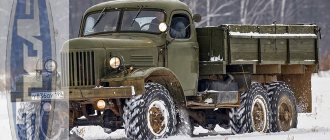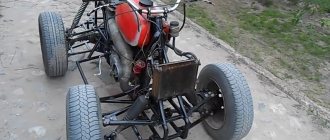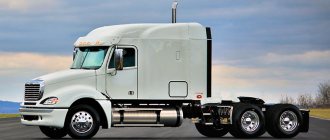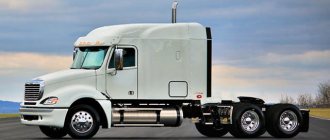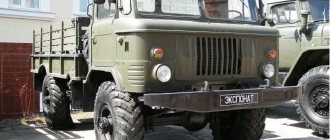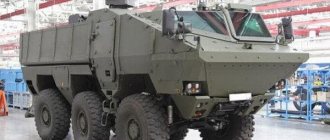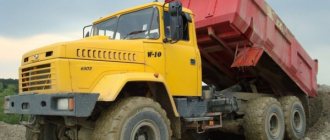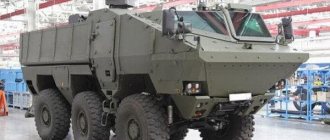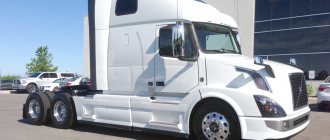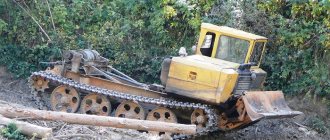Author: Kot shashlik
06 October 2015 08:48
Tags: Dodge WC-51 SUVs military equipment
2700
21
If the name of the WC-51 model is not familiar to everyone, then we use its more familiar “name”: “Dodge Three Quarters”. Why Three Quarters? Because the load capacity of this light all-wheel drive truck was 750 kilograms - three quarters of a ton. Since we had GAZ-AA one and a half trucks and ZIS-5 three-ton trucks, then why not have Dodge Three Quarters? That’s how easy it is for us to find out the carrying capacity of the car. Now, just as unobtrusively, let’s take it apart “piece by piece” and at the same time see what has quietly migrated from Dodge to our, at first glance, completely domestic trucks.
0
See all photos in the gallery
Dodge 3–4_zr 05–14
At the very end of 1942, a very young driver, Georgy Zakrzhevsky, drove an army Dodge out of the gates of the plant in Kolomna. Here they started assembling cars from American kits. A column of twenty Dodges drove into Kuskovo near Moscow, loaded up with ammunition and headed towards Smolensk. The final point of the route is Vitebsk. Or rather, not the end, but the beginning of the front-line life of fellow soldiers - new Dodges and recruit drivers...
Characteristics
Below are the main technical data of the Dodge WC51:
- load capacity – 750 kg;
- weight – 2,315 kg;
- base – 2.5 m;
- length/width/height – 4.23/2.12/1.87 m;
- front wheel track - 1.6 m;
- the same figure for the rear wheels – 1.65 m;
- ground clearance - 27.3 cm;
- type of power unit - six-cylinder petrol engine (four strokes, 3.8 liters, 92 horsepower);
- rpm (max.) – 3200;
- maximum speed – 88 km/h;
- Fuel consumption per 100 km is 29 liters on the highway.
The hood of the Dodge WC51 is predominantly flat with a curve. However, for sanitary and passenger modifications it is curved, since the front end from the cab of the WF32 series truck is used. The car body is made of solid metal, rectangular in shape. On the side there are compartments for ammunition and tools, which are accessible when the seats are folded down.
Squire
Usually the letters WC are deciphered as Weapons Carrier - weapon carrier. True, the family of military Dodges also included versions with the VC and VF indices. There was also an additional complex corporate classification with the letters T and G. However, the codes were codes, and the Doji weapons were actually carried - among the many modifications there were variants with machine guns. The origins of the family are in cars of the first half of the 1930s, when all-wheel drive was seriously taken up. And the closest predecessor of our hero is the 1939 VC1 commercial truck. In 1940, the WC family entered the production line, the bodies being as simple as possible and durable because there was a frame underneath.
In the cabin
The seats in the Dodge are bucket-shaped, hard, with good lateral support, which is important for the passenger when cornering. There are no doors, no handle to hold it. The dashboard is convenient and informative. The plates contain information about when to change gears, their diagram, and how to drain water from the cooling system. All inscriptions are in English.
The following equipment is available:
- pressure gauge;
- ammeter;
- speedometer;
- fuel level and water temperature indicators.
Speed markings are displayed in miles, and temperature gradations are shown in degrees Fahrenheit. All instruments are located low and centrally. The cabin has light switches, ignition switches, lighting, and even a ventilation drive for taking in outside air. The front glass opens 90 degrees upward or lies completely on the hood.
STEELS AND ALLOYS
In December 1942, the roads near Moscow seemed like a tablecloth to the young, untried drivers. It’s still not difficult to find a country road in the Moscow region. The almost empty Dodge jumps mercilessly on uneven surfaces, although I diligently slow down and avoid potholes where possible. But drivers of the Great Patriotic War praised American cars, among other things, for their smooth ride. And they were right! Compared to 1.5 and 3-ton vehicles, the Dodge with its hydraulic shock absorbers is much more comfortable.
The driver does not fly up with his head towards the canvas ceiling also because he is securely clamped between the seat and the steering wheel. Well, on the left it is held by a spare wheel. This is, however, a hindrance for quick evacuation from the car. To operate the gas pedal, you have to bend your right leg incredibly. The winch control lever is especially annoying. By the way, this car did not get it from the factory. Version WC-56 is a command vehicle without a winch. Exactly the same, but with a winch, was designated WC-57.
Equipment
The fuel filler neck is located on the driver's side. In the back there are tools: a pickaxe, a shovel, an axe. The car's towbar has a self-latching hook, which is very convenient to use. To remove it, just press the lever from below. The bumpers, which must be removed when transporting the gun, reduce the turning angle.
Near the left side light there is a connector for powering the towbar. On the starboard side, the absence of a door is even more striking. It is doubtful that an open cabin is an advantage, especially when driving in fairly cold weather. There are canisters for water and gasoline on the doorstep. A pair of canvas buckets are attached to them (using straps).
LIVING AND DEAD
From the stories of front-line drivers, I remember the driver of the Willis, who was tired of struggling with the deep, well-worn rut - he jumped out onto the field and almost immediately hit a mine...
Unlike the Willis, the Dodge-WC track is very close to that of domestic and American trucks of the Great Patriotic War. And in terms of cross-country ability, again according to army drivers, this is one of the best cars (if not the best) of that war. Huge ground clearance, tires with powerful lugs, and all-wheel drive made it possible to overcome very serious off-road conditions. The lack of a downshift was compensated for by the first, in which the manufacturer allowed driving no faster than 9 miles per hour (approximately 14 km/h). On normal roads, a car without a trailer does not need first gear at all.
Dodge WC-56: Fellow Soldiers
Exterior
The light elements of the military jeep are protected by reliable grilles. The original equipment of the army model does not include direction indicators. The bumper has an original curve, the upper part is equipped with a hole for a manual starter. By the way, starting a powerful engine with a crank is quite simple.
The Dodge WC51 has excellent stability due to its low center of gravity. Wide-profile wheels are placed under wide fenders. They are equipped with split discs, making it easy to replace tires. The spare tire is located in the driver's door, which causes some inconvenience when getting in, but saves usable space. The car in question does not have doors as such. The step with the spare wheel has a slight bend.
We celebrate the anniversary of Victory in the Great Patriotic War by getting acquainted with the commander's Dodge WC-56.
Dodge WC-56: Fellow Soldiers
Of course, the temptation is great to try the old Dodge, if not in extreme conditions, then in more serious conditions than ordinary country roads and a relatively flat frozen field. I don’t do this out of caution and, most importantly, out of respect for the car. She won hers!
I understand drivers who appreciated the Dodge for its excellent dynamics. Motor 92 hp for a car with a gross weight of about 3000 kg, it’s very good by the standards of the 1950s, and in comparison with our wartime cars, the “American” accelerates simply remarkably. Operating a gearbox without synchronizers is not a problem for a real driver. As does the desperate howl of the transmission, which subsides a little only in direct fourth gear. The main thing is that everything works properly, and it doesn’t matter what sound! The brakes on the Dodge are also much better than on domestic trucks, and are quite comparable to the brakes of many SUVs of the 1950s and even the early 1960s.
Most of the Dodges in the Red Army, and even in the Allied ones, were cargo-and-passenger vehicles and performed regular front-line service. But high-ranking military leaders, including Eisenhower, Patton, Marshall, Zhukov, rode such command “Dodges” from time to time.
Both senior officers, and especially the drivers, remembered the Dodge with warmth and respect for a long time.
It’s a shame to complain about the cold, heavy pedals, and an inflexible gear shift lever - both in front of yourself, and certainly in front of the boys who fought behind the wheel of such and other cars of the Great Patriotic War. There are fewer and fewer people left who can talk about this from their own experience. Cars live much longer than people. But Dodge and I tried to understand at least to the smallest extent how it all happened. And the main thing is to congratulate those who are alive, to remember those who fell and did not live to see the next Victory Day...
A bit of technology
0
As I already said, the “heart” of this car has six cylinders, 3.8 liters of volume and 92 horsepower, and this miracle is very low-speed: the maximum torque was reached around one and a half thousand revolutions, and the maximum number of revolutions did not exceed 3,200. This allowed an SUV can not only carry 750 kilograms of cargo, but also carry an anti-tank gun. Of course, this is due not only to the engine, but also to the transmission, which will be discussed below. In the meantime, here are a few facts about the T-215 engine.
0
Our regular readers already know that at the very beginning of the thirties, the USSR bought a license from the United States for the production of Ford-A and Ford-AA, from which the GAZ-A passenger car and many of its modifications and the legendary GAZ-AA “lorry” were obtained. However, already in the late thirties, after the release of the Emka GAZ-M, the government of the Union decided that it was enough to drive cars whose past was clearly ideologically inconsistent, bourgeois, capitalist and therefore shameful. The ruling circles were clearly not happy with the nickname GAZ-A “Soviet Ford”, so they began to get rid of them, voluntarily-compulsorily (i.e. usually forced) replacing GAZ-A with “Emki”. Outwardly, they were not too similar, so the Emka could already be passed off as “your” car, with the right worker-peasant reputation. Actually this is not true. But this time can be considered the beginning of the era of hidden borrowing of Western technologies by the Soviet side. There was no talk about licenses at this time (as during the war and in the first post-war years). Moreover, by the mid-forties we already had a lot of engines and imported equipment; all that remained was to choose the most successful one. It so happened that the Dodge D5 engine was to the liking of Soviet specialists. Therefore, the engine of the later GAZ-51, and then the GAZ-52, is still the same American unit with very minor changes. It was installed on GAZ-61, GAZ-63, GAZ-12 ZiM and GAZ M11-73 (one of the Emka modifications, but they should not be confused with the GAZ-M1, which had a 50-horsepower GAZ-M engine, resulting from the development of the Ford-B engine). The Soviet GAZ-11 engine is an analogue of Dodge. The history of these engines is generally extremely confusing, but let’s pay attention to this thing: the agreement signed with Ford in 1929 provided for the Soviet side to receive technical documentation for all units developed by Ford over the next nine years. In 1938, the transfer of documentation ended, but around the same time the development of the GAZ-51 began, which was completed only after the war. The easiest way was to borrow the engine, especially since the Dodge unit, which “moved” almost entirely to the GAZ-51, was produced by the Americans back in 1937.
0
There is talk on the Internet that these motors were purchased under license. However, it is not possible to confirm or refute this information. Even if a document confirming the right to legally use Dodge engines exists, it is extremely difficult to find: no one was going to advertise the borrowing of the unit even then, the times of obvious cooperation with Ford had already passed, and publicly flirting with Dodge became unforgivable for the young Soviet state. Without at all claiming the Pulitzer Prize in the field of investigative journalism (I wonder if this is what they give it for?), I will express my point of view: rather, the license was acquired, but no one wanted to admit it. And now it is very difficult to get a definite answer to this question. Be that as it may, the GAZ-51 head gasket, according to restorers, is also suitable for Dodge “3/4”. But that's not all. Let's look at the chassis of the SUV. Our attention is drawn to the double-sided linkage shock absorbers of the front suspension. The fact is that we had similar ones, but only one-sided ones that worked for compression. Therefore, they were often placed in pairs in opposite directions. Dodge's, I repeat, are double-sided. And it can hardly be considered a coincidence that after the appearance of Dodges and Studebakers in the USSR, the same shock absorbers appeared on our GAZs, and then on some UAZs. At the same time, they are so the same that they differ practically nothing from the American ones.
What was borrowed legally and what was not is not for us to judge. And is it worth it? Nowadays it’s much more interesting to get behind the wheel of a Three Quarter and give the gas along the road.
Peculiarities
Three arc-shaped mounts for mounting an awning can be installed on the body of the jeep in question. The rigidity of the covering is ensured by a medium canvas belt. The upper part of the seat back is fixed to the front edge of the front side with a chain at an angle of 45 degrees. The floor has five stiffening ribs and is adapted for mounting a rack designed for a small-caliber cannon or machine gun.
The tailgate is hinged and secured with a pair of chains. The body sides consist of three elements connected by welding. The front parts are stamped and equipped with a hook for attaching a tarpaulin. The SUV is painted in olive protective color with a special matte paint. In addition, the edge of the left bumper or part of the rear side could be covered with white.
The tarpaulin awning is divided into three components. The roof is attached to it from the front using a rope fastening. The second part is fastened to the windshield frame with buttons. The rear part of the awning is attached to body hooks. There is a rectangular valve in the middle of the structure.
Conclusion
The American military vehicle Dodge WC51 is a classic representative of the US automobile industry during the Second World War. It has objective advantages expressed in power, good handling and load capacity, as well as a well-thought-out body design.
Along with this, the SUV in question has some shortcomings. For example, an open cabin is not a very practical element in the cold season. In addition, the steering is a bit heavy, and a full tank of gasoline will last for 300 kilometers, with a consumption of about 30 liters per hundred.
Test Drive
An American car starts with an electric starter. The engine operates smoothly, smoothly and quietly, given its power. The front axle activation lever is located near the parking brake. Since there are no synchronizers on the gearbox, you will need to use double squeezing. By the way, turning on the desired mode is not so easy. Having a certain skill, you can accelerate this car quite quickly if you start from second gear, considering that there is no reduction speed on the device.
The SUV is easy to drive on the road. It corners well and holds a straight line. The relatively small wheelbase makes it possible to turn around in small areas. The hydraulic brakes are reliable and perfectly stop a heavy vehicle. The test drive of the Dodge WC 51 surprised and pleased car enthusiasts. There are two serious drawbacks. Firstly, the wind interferes even in warm weather, not to mention the frost. Secondly, the steering is a bit heavy. The width of the wheels and the weight of the car have an impact.
